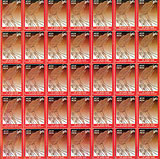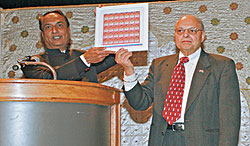|
How many NRIs and their children in North America—the US and Canada—know about the Gadar movement and its role in India’s freedom struggle exactly 100 years? Very few.
The Gadar (means revolt) movement was started by NRIs (let us call our first Indian immigrants) on the West Coast of the US and Canada to rid India of British rule.
Thousands of these daring people left for India to throw out the British. Scores were hanged and others thrown in jail for the rest of their life.
Now, thanks to the efforts of the Global Organization of People of Indian Origin (GOPIO), the Indian government has officially accorded these heroes the respect they deserved in this centenary year of the Gadar movement.
Recognition includes a postal stamp released by Prime Minister Manmohan Singh at the Parvasi Bharatiya Divas and upgrading the Gadar museum in San Francisco - where the movement started - to a functional library and museum, says GOPIO chairman Inder Singh (seen with Indian consul general in San Francisco N. Parthasarathi showing the stamp) in the above picture in an interview from Los Angeles.
 |
 |
| Mr Inder Singh, Chairman, GOPIO International, releasing a Gadar stamp alongside India’s Consul General in San Francisco, Mr N. Parthasarathi |
Tell us about the Gadar movement and its sacrifices for India's independence.
GOPIO is rejoiced that finally Prime Minister Dr. Manmohan Singh recognized the Gadar movement as part of India's independence movement at the last Parvasi Bharatiya Divas by saying, "This year, we are celebrating the centenary of the Gadar Movement, which was a luminous spark of support in distant California for the struggle for independence being waged at home in our country. Apart from commemorating it by the issue of a special postage stamp, we will also upgrade the Gadar Memorial in San Francisco into a functional museum and library with a sculpture to honor the Gadari Babas, the heroes of the great movement."
Since most Indians in the US and Canada or even elsewhere don't know much about the Gadar movement, let me give a brief history of it. First immigrants from India formed the Hindustan Association of the Pacific Coast in 1913 in Astoria, Oregon, to liberate India from British colonialism. Its headquarters was established in San Francisco from where a magazine titled Gadar was also launched. Gadar magazine became very popular among Indians in a short period of time and the Hindustan Association of the Pacific Coast itself became known as the Gadar Party under the leadership of Lala Har Dayal and Sohan Singh Bhakna. Many Indian students at the University of California at Berkeley were its early members, including Karatr Singh Sarabha, Tarak Nath Das and Maulvi
Barkatullah.
During 1914-15, as many as 8,000 Indians went back to India from all over the world, mostly from the US and Canada, to throw the British out of India. Their attempt did not succeed and they paid a heavy price for their valiant effort: 46 were given the death sentence, 69 were given life imprisonment, over 125 were given varying terms of imprisonment, 15 were convicted in the Hindu-German Conspiracy Trial in San Francisco and several people from the armed forces were court-martialled in India.
Our efforts to get recognition for Gadar heroes began in 2003 when GOPIO, in collaboration with the National Federation of Indian Associations (NFIA) organized the 90th anniversary of the Gadar movement in Fremont, California. Former president K.R Narayanan made a special trip to the US to be the chief guest for the anniversary event.
And then in June 2011, we handed over a letter to India's Consul General in San Francisco, asking the Government of India to commemorate the centenary of the Gadar movement. A similar request was made to the Indian ambassador as well as other high-ranking officials and ministers in India. GOPIO also sent a request to the prime minister's office (PMO). Following our relentless efforts, the PMO finally sent instructions to the Ministry of Overseas Indian Affairs to make the Gadar centenary a part of Parvasi Bharatiya Divas in 2013. The ministry of culture was instructed to issue a postage stamp.
Some of our suggestions for the commemoration of the Gadar centenary were accepted. And at this year's PBD, the Prime Minister recognized the role of the Gadar movement in his inaugural speech. A postal stamp and an exhibit were launched to honour those unsung heroes. The stamp was unveiled by Prime Minister Manmohan Singh at the Parvasi Bharatiya Divas in honour of Gadar heroes of India's freedom. In the US, we launched the commemoration of the Gadar centenary at the Indian embassy in November last year, with ambassador Nirupama Rao as the chief guest and ambassador Bayney Karran of Guyana, ambassador Dr Neil Parsan of Trinidad & Tobago, and ambassador Subash Mungra of Suriname also participating.
We convinced Sayantan Chakraverty, publisher of India Empire, an NRI magazine from Delhi, to publish a Gadar supplement which was distributed at the PBD in Kochi. We collaborated with Munish Gupta of PIOTV.COM to make a 20-minute documentary on the Gadar movement. Now we are publishing a book in April on the Gadar movement. As to the late recognition of their sacrifices, I am not sure why. But probably due to ideological differences. The Congress was committed to the Gandhian method of getting India's independence while Gadarites wanted to take it with the force of arms.
Do you think there is enough awareness about the Gadar movement among the Indian community in the US and Canada?
The movement started 100 years ago when there were only a few thousands of Indians in the US and Canada.. Now there are over 3.2 million in the US alone and about a million in Canada.
History of Indians in the US is not taught in schools. So, there is no awareness in the generation of Indians who went to school in this country. Nor is there any awareness among the first generation of Indian immigrants who have never made any effort to learn about their heritage in this country.
Even in India, history of the Gadar movement is not included in the history of India's independence movement. Punjabis may be aware of the movement as a majority of Gadar heroes were Punjabis and annual Gadari melas are organized at several places in Punjab.
Why do you think the community needs to know about their sacrifices?
If we, Indians in the US and Canada, want others to know about us, then we must first know who we are. We can ignore our heritage at our own peril.
"A people without the knowledge of their past history, origin and culture is like a tree without roots,'' according to Marcus Garvey who is the national hero of Jamaica.
So how are you celebrating the 100th anniversary of the Gadar movement?
The Gadar centennial commemoration is of enormous historical significance for the Indian community here. A series of commemoration events during 2013, in collaboration with several GOPIO chapters, NRI/PIO organizations, government and international agencies, individuals and institutions, are being planned in New York, Los Angeles, Washington, DC, Atlanta, Miami, Chicago, Houston and San Francisco.
|